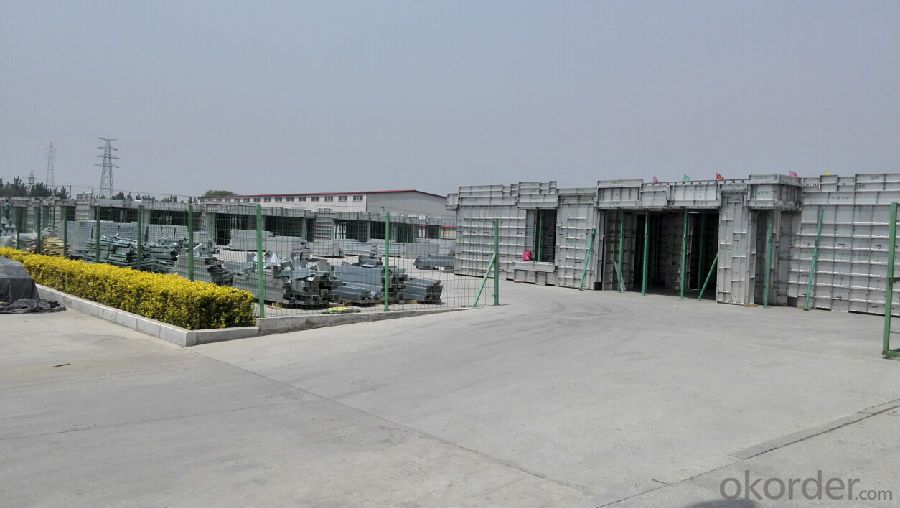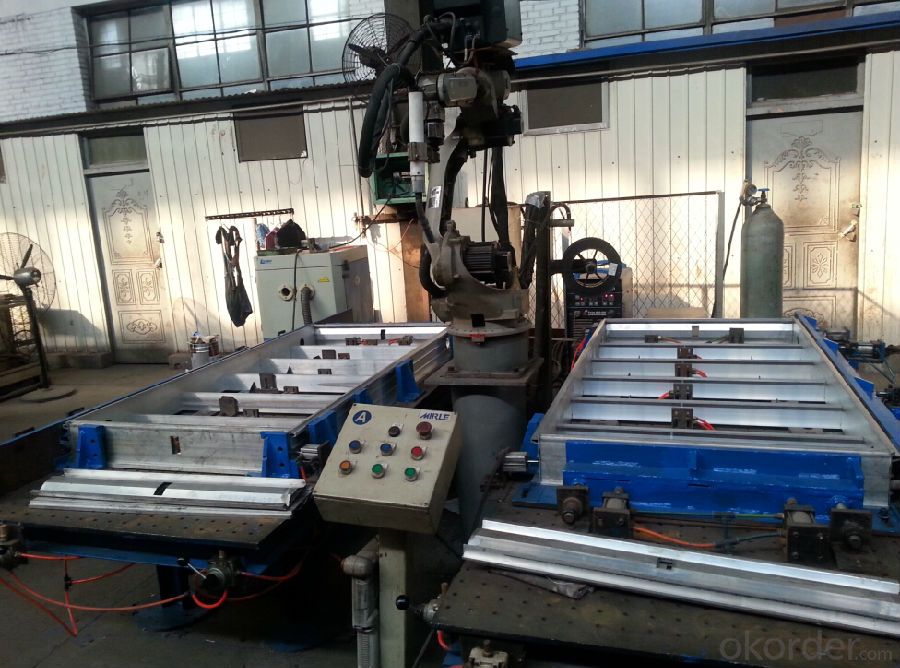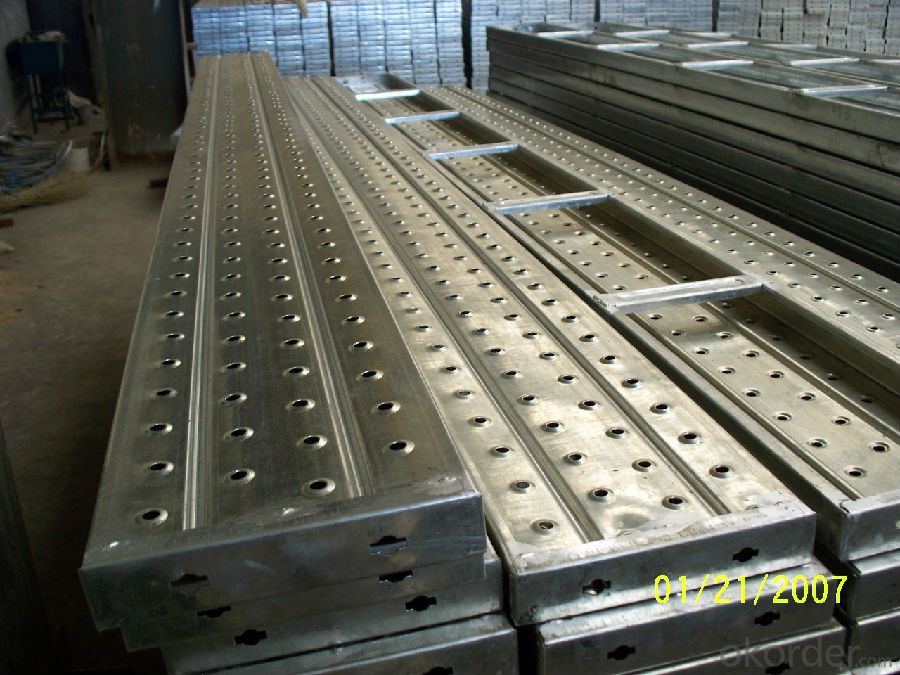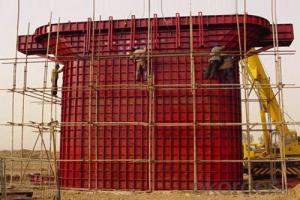Steel Formwork for High Residential Buildings with Recycling
- Loading Port:
- Tianjin
- Payment Terms:
- TT OR LC
- Min Order Qty:
- 200 pc
- Supply Capability:
- 100000 pc/month
OKorder Service Pledge
OKorder Financial Service
You Might Also Like
Introduction for Steel Formwork :
Steel Formwork:used in highway,railway,bridge,tunnel and shearing wall,etc.Our company CNBM which is one of the largest State-Owned Enterprises in China which established in 1984 , has gained the confirmation from the specialist of China Architecture Scence Institute, and has been used by many building operation units and has been highly praised.In 2014, the total turnover volume of CNBM exceeds US$410 billion dollars with a total staff of 180,000. CNBM is listed in the World Top 500 Enterprises !
Characteristic for Wholly Steel Formwork :
1. High Smooth Surface
2. Convex ling for Edge Rib
3. Specialized Connection Pin for Edge Rib Connection
4. High Stiffness for Steel Surface
5. Light Weight for saving producing cost
6. Fast Separate and Easy transport
7. Recycling using
8. Scientific and Reasonable design to meet different working condition
Parameter and Specification :
Code | Size (mm) | Weight (KG) | Code | Size (mm) | Weight (KG) |
P12021 | 1200*2100*55 | 102.96 | P4018 | 400*1800*55 | 28.3 |
P12018 | 1200*1800*55 | 88.4 | P4015 | 400*1500*55 | 23.8 |
P12015 | 1200*1500*55 | 74.15 | P4012 | 400*1200*55 | 19.1 |
P12012 | 1200*1200*55 | 60.11 | P4009 | 400*900*55 | 14.6 |
P10018 | 1000*1800*55 | 76.01 | P4007 | 400*750*55 | 12.3 |
P10015 | 1000*1500*55 | 63.96 | P4006 | 400*600*55 | 9.95 |
P10012 | 1000*1200*55 | 60.11 | P3018 | 300*1800*55 | 20.7 |
P10009 | 1000*900*55 | 39.32 | P3015 | 300*1500*55 | 17.4 |
P9018 | 900*1800*55 | 70.89 | P3012 | 300*1200*55 | 14 |
P9015 | 900*1500*55 | 59.47 | P3009 | 300*900*55 | 10.7 |
P9012 | 900*1200*55 | 48.03 | P3007 | 300*750*55 | 8.8 |
P7518 | 750*1800*55 | 57.8 | P3006 | 300*600*55 | 7.3 |
P7515 | 750*1500*55 | 48.47 | P3004 | 300*400*55 | 5.46 |
P7512 | 750*1200*55 | 39.16 | P2515 | 250*1500*55 | 15.17 |
P7509 | 750*900*55 | 29.85 | P2512 | 250*1200*55 | 12.24 |
P7507 | 750*750*55 | 24.81 | P2509 | 250*900*55 | 9.32 |
P6018 | 600*1800*55 | 43.1 | P2507 | 250*750*55 | 7.71 |
P6015 | 600*1500*55 | 36.3 | P2506 | 250*600*55 | 6.39 |
P6012 | 600*1200*55 | 31.7 | P2015 | 200*1500*55 | 11.6 |
P6009 | 600*900*55 | 23.9 | P2012 | 200*1200*55 | 9.4 |
P6007 | 600*750*55 | 18.55 | P2009 | 200*900*55 | 7.1 |
P6006 | 600*600*55 | 16.25 | P2007 | 200*750*55 | 5.9 |
P5018 | 500*1800*55 | 36.27 | P2006 | 200*600*55 | 6.39 |
P5015 | 500*1500*55 | 30.15 | P2004 | 200*450*55 | 3.64 |
P5012 | 500*1200*55 | 25.55 | P1515 | 150*1500*55 | 9.5 |
P5009 | 500*900*55 | 20.38 | P1506 | 150*600*55 | 4 |
P5007 | 500*750*55 | 15.48 | P1504 | 150*450*55 | 2.98 |
P5006 | 500*600*55 | 13.58 | P1015 | 100*1500*55 | 7.5 |
Code | Size (mm) | Weight (KG) |
P1012 | 100*1200*55 | 6.9 |
P1009 | 100*900*55 | 4.6 |
P1007 | 100*750*55 | 3.8 |
P1006 | 100*600*55 | 3.1 |
P1004 | 100*450*55 | 2.33 |
E1515 | 150*150*1500 | 15.2 |
E1512 | 150*150*1200 | 12.26 |
E1509 | 150*150*900 | 9.34 |
E1507 | 150*150*750 | 7.77 |
E1506 | 150*150*600 | 6.46 |
E1504 | 150*150*450 | 4.87 |
E1015 | 100*150*1500 | 13.13 |
E1012 | 100*150*1200 | 10.61 |
E1009 | 100*150*900 | 8.07 |
E1006 | 100*150*600 | 5.44 |
Y1018 | 100*150*1800 | 14.56 |
Y1015 | 100*150*1500 | 12.29 |
Y1012 | 100*150*1200 | 9.72 |
Y1009 | 100*150*900 | 7.46 |
Y1007 | 100*150*700 | 6.19 |
Y1006 | 100*150*600 | 5.19 |
Y1004 | 100*150*450 | 3.92 |
J0018 | 50*50*1800 | 4.34 |
J0015 | 50*50*1500 | 3.7 |
J0012 | 50*50*1200 | 2.94 |
J0009 | 50*50*900 | 2.3 |
J0007 | 50*50*750 | 1.9 |
J0006 | 50*50*600 | 1.5 |
J0004 | 50*50*450 | 1.13 |
FAQ :
1. Who are we ?
We , CNBM , are a State-Owned Enterprise which established in 1984 , have 32 years experience ,enjoy high reputation .
2. Our Advantage :
Customized products , we have our own R&D department , we can design the drawing and suggest the suitable solution for your project .
3. Our after-Sales Service :
The international Sales Manager and Engineer can go to your job site for work direction and help you deal with your project .
Factory Photos :





- Q:What are the factors to consider when selecting steel formwork for a project?
- When selecting steel formwork for a project, there are several factors to consider. Firstly, the size and complexity of the project should be taken into account. The steel formwork should be able to accommodate the specific dimensions and requirements of the project. It is important to consider the shape and design of the structure, as well as any unique features or details that may require customized formwork. The strength and durability of the steel formwork are crucial factors. It should be able to withstand the weight and pressure of the concrete during pouring and curing. Steel formwork with high load-bearing capacity and resistance to deformation is desired. Additionally, the formwork should be able to resist rust and corrosion, especially in areas with high humidity or exposure to water. The ease of assembly and disassembly is another important consideration. Steel formwork that can be quickly and efficiently assembled and dismantled can save time and labor costs. The formwork should have a user-friendly design, with clear instructions and minimal tools required for installation. Compatibility with other construction equipment and processes, such as cranes or concrete pumps, should also be considered. The reusability of the steel formwork is another factor to consider. If the project requires multiple pours or if there are future projects that may benefit from the same formwork, it is important to select formwork that can be easily dismantled, cleaned, and reused. This not only reduces waste and environmental impact but also provides cost savings in the long run. The availability and cost of the steel formwork should also be taken into account. It is important to choose a supplier or manufacturer that can provide the required quantity of formwork within the project's budget and timeframe. Comparing prices and quality from different suppliers can help in selecting the most cost-effective option. Lastly, safety should always be a top priority. The steel formwork should meet the necessary safety standards and regulations. It should be stable, secure, and able to withstand potential accidents or mishaps during the construction process. Additionally, the formwork should provide adequate protection for workers, such as guardrails or safety nets, to prevent falls or injuries. By considering these factors, the selection of steel formwork for a project can be done in a well-informed and efficient manner, ensuring the success and quality of the construction process.
- Q:Can steel formwork be used for bridge piers?
- Yes, steel formwork can be used for bridge piers. Steel formwork is a versatile and durable option that is suitable for constructing various types of structures, including bridge piers. It offers numerous advantages such as high strength, ease of assembly and disassembly, and flexibility in design. Steel formwork allows for precise shaping and reinforcement of the bridge piers, ensuring structural integrity and stability. Additionally, steel formwork can withstand the high loads and pressures exerted by the bridge piers during their lifespan. Therefore, steel formwork is a reliable and commonly used choice for constructing bridge piers.
- Q:Can steel formwork be used for precast concrete facades with intricate patterns?
- Absolutely! Precast concrete facades with intricate patterns can indeed utilize steel formwork. Renowned for its robustness and longevity, steel formwork proves ideal for fashioning elaborate and meticulous designs. The adaptability of steel enables the crafting of intricate patterns, textures, and contours on the concrete surface. Moreover, steel formwork can be effortlessly tweaked and altered to accommodate any desired pattern or design, rendering it a favored option for precast concrete facades that demand intricate patterns or artistic elements. Ultimately, steel formwork offers the vital support and flexibility necessary to accomplish intricate designs in precast concrete facades.
- Q:How does steel formwork affect the overall noise transmission in the building?
- Steel formwork can have a significant impact on the overall noise transmission in a building. Compared to other types of formwork materials, such as wood or plastic, steel is much denser and less porous. This density and lack of porosity make steel formwork highly effective in reducing the transmission of sound waves through the structure. When steel formwork is used, it creates a more rigid and solid structure, minimizing the vibrations caused by external noise sources. This rigidity helps to prevent the amplification and propagation of sound waves throughout the building. As a result, the overall noise transmission is significantly reduced, creating a quieter and more comfortable environment for the occupants. Furthermore, steel formwork can also act as a barrier to airborne sound, preventing sound waves from passing through the walls or floors. This is particularly important in buildings where privacy is crucial, such as hospitals, offices, or residential buildings. In addition to its soundproofing capabilities, steel formwork also offers other advantages. It is durable, reusable, and has a longer lifespan compared to other formwork materials. This not only reduces construction costs but also contributes to the sustainability of the building. Overall, the use of steel formwork in construction has a positive impact on the overall noise transmission in the building. Its density and rigidity effectively reduce the transmission of sound waves, creating a quieter and more comfortable environment for the occupants.
- Q:What are the main components of a steel formwork system?
- The main components of a steel formwork system are the steel panels, walers, stiffeners, and connectors. 1. Steel Panels: These are the primary components of a steel formwork system. They are typically made of high-quality steel and come in various sizes and shapes. Steel panels provide the necessary strength and rigidity to hold the concrete in place during the construction process. They are designed to be easily assembled and disassembled, allowing for efficient use on different construction projects. 2. Walers: Walers are horizontal beams or rods that are used to connect and brace the steel panels. They help distribute the load of the concrete and provide additional strength to the formwork system. Walers are usually made of steel or timber and are placed along the edges of the formwork to maintain its shape and prevent any deformation. 3. Stiffeners: Stiffeners are vertical or diagonal members that are added to the steel formwork system to increase its stability and resistance to lateral forces. They are typically made of steel and are placed at regular intervals to provide additional support and prevent any buckling or twisting of the formwork system. Stiffeners are essential for ensuring the safety and integrity of the formwork during the pouring and curing of the concrete. 4. Connectors: Connectors are used to securely fasten the steel panels and other components of the formwork system. They can include various types of bolts, nuts, clamps, or pins. Connectors play a crucial role in maintaining the alignment and stability of the formwork, ensuring that it can withstand the pressure exerted by the wet concrete. They are designed to be easily adjustable and removable, allowing for quick assembly and disassembly of the formwork system. Overall, a steel formwork system is composed of steel panels, walers, stiffeners, and connectors. These components work together to provide the necessary strength, stability, and flexibility required for the construction of concrete structures. The use of steel in the formwork system ensures durability, reusability, and ease of assembly, making it a popular choice in the construction industry.
- Q:How does steel formwork handle different concrete surface texture requirements?
- Steel formwork is a versatile and durable option that can handle a variety of concrete surface texture requirements. With its adjustable and customizable design, it allows for different surface finishes to be achieved. One way steel formwork meets different concrete surface texture requirements is by being easily modified and adapted. By adjusting the steel formwork panels, various finishes such as smooth, textured, or patterned concrete can be accommodated. This flexibility makes it suitable for a wide range of construction projects, from simple slabs to complex structures. Additionally, steel formwork ensures a smooth and consistent surface, which is crucial for achieving the desired concrete finish. The rigid and sturdy nature of steel prevents any distortions or imperfections from occurring during the pouring and curing process, resulting in a uniform surface texture, regardless of the design's complexity. Moreover, steel formwork offers excellent resistance to wear and tear, making it suitable for projects that require repetitive use or high-volume concrete pouring. Its durability allows it to maintain its shape and integrity even after multiple uses, ensuring consistent concrete surface texture requirements are met over time. In conclusion, steel formwork is a reliable and adaptable solution for addressing various concrete surface texture requirements. Its adjustability, durability, and ability to provide a smooth and consistent surface make it an ideal choice for achieving different finishes, regardless of the project's complexity.
- Q:What is the maximum load that steel formwork can bear?
- The maximum load that steel formwork can bear depends on various factors such as the thickness and quality of the steel, the design and construction of the formwork, and the specific application or intended use. It is advised to consult the manufacturer's specifications, engineering calculations, or professional advice to determine the exact maximum load that a particular steel formwork can withstand.
- Q:How does steel formwork handle different concrete finishes?
- Steel formwork is a popular choice in construction due to its durability and versatility. When it comes to handling different concrete finishes, steel formwork has proven to be highly effective. One of the key advantages of steel formwork is its smooth and rigid surface. This allows for a wide range of concrete finishes to be achieved with ease. Whether it is a smooth finish, textured finish, or even an exposed aggregate finish, steel formwork can handle them all. For smooth finishes, the steel formwork provides a level and even surface, allowing the concrete to be poured and finished seamlessly. The smooth surface of the steel formwork also helps in achieving a high-quality finish with minimal imperfections such as air pockets or surface blemishes. In cases where textured finishes are desired, steel formwork can easily accommodate various textures. This can be achieved by using specialized liners or inserts that are fixed to the steel formwork. These liners or inserts create the desired texture on the surface of the concrete as it sets, resulting in a textured finish. Additionally, steel formwork can handle exposed aggregate finishes exceptionally well. Exposed aggregate finishes involve exposing the aggregates (such as stones or gravel) in the concrete mix to create a decorative and textured surface. Steel formwork with its smooth surface allows the aggregates to be evenly distributed and exposed when the concrete is finished and cured. Moreover, steel formwork is known for its reusability. This means that it can be used multiple times without compromising its structural integrity or surface quality. This reusability factor makes steel formwork a cost-effective choice for handling different concrete finishes as it can be reused for various projects. In conclusion, steel formwork is highly versatile and can handle different concrete finishes effectively. Its smooth and rigid surface allows for a range of finishes to be achieved, including smooth, textured, and exposed aggregate finishes. Additionally, the reusability factor of steel formwork makes it an economical choice for contractors and construction projects.
- Q:Can steel formwork be used for architectural concrete slabs?
- Yes, steel formwork can be used for architectural concrete slabs. Steel formwork offers several advantages in terms of strength, durability, and versatility compared to other types of formwork materials. It provides a rigid structure that can withstand the pressure of fresh concrete, ensuring accurate and precise placement of the slabs. Additionally, steel formwork can be easily reused multiple times, making it cost-effective and environmentally friendly. Its smooth surface also results in a high-quality finish for architectural concrete slabs. However, it is essential to ensure proper insulation and release agents are used to prevent the steel from transferring heat or causing concrete adherence issues. Overall, steel formwork is a reliable and efficient choice for creating architectural concrete slabs.
- Q:How does steel formwork affect the overall productivity of the construction process?
- Steel formwork can have a significant impact on the overall productivity of the construction process. Firstly, steel formwork is known for its durability and strength, allowing it to withstand the high pressures and forces exerted by concrete during the pouring and curing stages. This durability ensures that the formwork remains intact and stable, reducing the need for repairs or replacements, thus saving time and cost. Moreover, steel formwork offers increased efficiency in terms of assembly and disassembly. Steel panels can be easily connected and detached, allowing for quick and smooth installation and removal. This ease of use ensures that the construction process can progress at a faster pace, increasing overall productivity. Additionally, steel formwork provides a smooth and high-quality finish to concrete structures. The precise and rigid nature of steel formwork prevents any deformations or warping during the pouring and curing stages, resulting in a superior surface finish. This eliminates the need for additional finishing work, such as plastering or smoothing, thereby reducing the time and effort required for post-construction tasks. Furthermore, steel formwork is highly adaptable and can be customized to fit various shapes and sizes, enabling the construction of complex structures with ease. This flexibility allows for greater design freedom and eliminates the need for additional supporting structures, reducing construction time and increasing productivity. Lastly, steel formwork is reusable and can be used for multiple projects, unlike traditional timber formwork which often needs to be discarded after a single use. This reusability not only reduces material waste but also saves time and cost in procuring new formwork for each project. In conclusion, steel formwork significantly enhances the overall productivity of the construction process. Its durability, ease of assembly, high-quality finish, adaptability, and reusability all contribute to faster construction timelines, reduced costs, and improved efficiency, making it a preferred choice for many construction projects.
1. Manufacturer Overview |
|
|---|---|
| Location | |
| Year Established | |
| Annual Output Value | |
| Main Markets | |
| Company Certifications | |
2. Manufacturer Certificates |
|
|---|---|
| a) Certification Name | |
| Range | |
| Reference | |
| Validity Period | |
3. Manufacturer Capability |
|
|---|---|
| a)Trade Capacity | |
| Nearest Port | |
| Export Percentage | |
| No.of Employees in Trade Department | |
| Language Spoken: | |
| b)Factory Information | |
| Factory Size: | |
| No. of Production Lines | |
| Contract Manufacturing | |
| Product Price Range | |
Send your message to us
Steel Formwork for High Residential Buildings with Recycling
- Loading Port:
- Tianjin
- Payment Terms:
- TT OR LC
- Min Order Qty:
- 200 pc
- Supply Capability:
- 100000 pc/month
OKorder Service Pledge
OKorder Financial Service
Similar products
New products
Hot products
Hot Searches
Related keywords




























